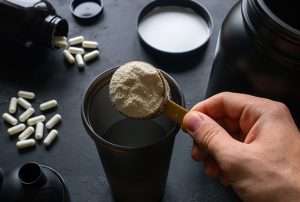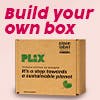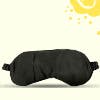How to build lean muscle with plant-based protein?

To get started, it’s important to challenge your body through physical activity. But, without proper nutrition, your progress would soon stall.
High-protein foods are essential for gaining muscles, including carbohydrates and fats since they are also important sources of energy that helps vital functions within the body.
To gain lean muscles, one should exercise regularly and eat more calories from nutrient rich foods. Find out how you can build muscle with plant protein.
1. Calculate Your Calories

Just like any other meal-plan dedicated to building more muscles, a plant-based diet is no different. One should start by calculating the number of calories needed each day.
Daily calorie requirement of a person depends on their normal activity levels and the energy needed to perform those activities.
You can start by figuring out you Basal Metabolic Rate (BMR). BMR is the amount of calories you expend simply by existing. This takes in to account your gender, age, height, and weight.
Once you figure that out, combine that number with your actual activity level – any form of additional movements beyond just existing, like running errands, walking the dog, walking or taking the stairs, or hitting the gym. This will give you an approximate idea of the total number of calories you expend daily.
So for example, if your daily calorie expend is 2,500 calories per day, you need 2,500 calories just to maintain weight. And in order to gain muscles, you would need to consume more than 2,500, preferably from natural plant-based source for a better nutritional profile. Combine that with resistance weight training, and you’re good to go. Your muscle formation will begin in no time.
2. Figure Out Your Macros

One should eat smart by paying attention you’re your macros – protein, fats and carbohydrates.
A typical diet needed for muscle building should have 40 per cent carbs, 30 per cent protein and 30 per cent fat. A little variation to this rule is possible from person to person but ideally this ratio allows you to get enough protein to stimulate muscle growth, enough carbs to give you energy, and enough fats to help your body absorb nutrients before and after a workout.
You can also use a macro tracking app to hit the right numbers and making an informed decision.
3. Understanding Calorie vs. Nutrient Density

It’s not just about the calorie intake; it’s about the amount of nutrients you get along with the calories you are consuming.
Nutrient density of a food refers to number of nutrients you can obtain from that food, given the number of calories it contains. It is a simple way to determine the link between nutrient content and calorie count.
Nutritionally dense foods provide the most nutrients for the fewest number of calories. These nutrients are essential for the natural detoxification, proper functioning of immune system and cellular repairs that protect us from diseases and bacteria.
If you compare a diet of plant-based whole foods with processed foods like chips, pizza, candy or cream, you might end up getting the same amount of calories. But, what you’ll get from fresh fruits, vegetables, legumes, nuts and seeds are also a healthy amount of nutrients like vitamins, minerals, amino acids, antioxidants, fiber, water, nitric acid and other phytonutrients.
Therefore, figuring out nutrient dense food items is the first step in adapting to a plant-based diet.
4. Focus on Whole Foods

By figuring out the calorie content of a certain food item against its nutrient density, you’ll be able to build your muscle mass in no time. Of course you would want to consume as many nutrient rich foods as possible.
You can get started with these five staple foods at your disposal, which is super convenient to get and is also high on their nutrient-to-calorie ratio:
- Potatoes
- Oats
- Beans and lentils
- Brown rice
- Bananas and other fruits
Variations of these five foods alone can help you build muscles and rev up your bulking efforts.
5. Eat at the Same Time Everyday

When you want to build muscle, you will need to keep your body fuelled throughout the day. Predetermining your meals times and eating at the same time can help you make steady progress on your muscle building journey.
Make sure to eat well-rounded meals to keep you going throughout the day with a balance of breakfast, lunch, dinner and snacks.
You can eat a small snack two hours before your workout and about 30 minutes after your workout to keep your energy levels high. Go heavy on the carbs and protein and light on the fat. Carbs will give you energy while protein will help you build muscles. Meanwhile, fat can slow down your affect your performance at the gym.
Your calorie and nutrient counts should factor into your pre and post workout snacks that you take throughout the day.
6. Track Your Progress and Commit to your Workouts

After you have set the foundation for your bodybuilding goals by taking care of your nutrition and exercise regime, the next step is to create realistic goals that are attainable and easy to track.
You can plan for a cardio and muscle-building session five to six times a week and work on each muscle group at least once a week. Keeping consistency will help you in strengthen your core and build muscles.
Use a fitness tracker to monitor your workouts and count calories from your meals. Tracking your progress will give you the motivation to keep pushing your limits.
These were a few techniques and ways you can build muscle with plant protein. Go ahead and give it a try, you’d be surprised to see the results!
You can also buy our Plant-based protein powder from Amazon here:














